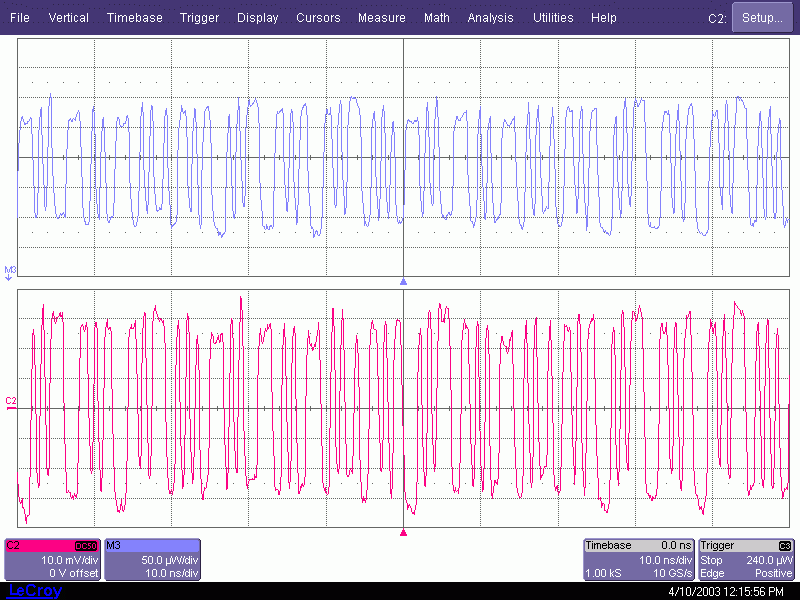 |
optical sniffer for Gbit/s
fibre systems |
|
| Home | Trackers | Notes | Meetings | Subsystems | Search |
| Last year, I wanted to have a look on the eye diagram of my
digital optical link system. As these so-called opto-electrical
converters do exist as commercial equipment, I tried to get one and was
shocked by the price (about CHF 10000).. so I decided to build one
myself. Actually, this is not so difficult... so I called it the
'optical sniffer'. It is not as sophisticated as commercial equipment,
but the results are quite surprising. |
| The key component to the sniffer is a fast PIN diode. These
come today included with a pre-amplifier in a single package for direct
fibre coupling. In my case, I used a HFD3381-102
from Honeywell, which has excellent bandwidth of 2.5 GHz. In principle,
it has a direct differential output capable of driving 50 Ohms for each
leg, so this could well drive directly a little bit of cable and a
scope input. To isolate the PIN diode from any load variations (cable
mating/demating) and have a little bit more power, we just have to add
a GHz bandwidth amplifier behind. That's easier as it sounds, as the
communications industry has developed MMICs, which are internally
matched gain blocks with 50 Ohm impedance. These devices, which most
popular representatives are the ERA series from Mini-Circuits and their
successors GALI (same company), have gains between 12 and 20 dB in a
4-pin package: 2 ground, one in and one out. The supply voltage is
inserted with a bias resistor at the output, that's all. Bandwidth of
those devices: 8-10 GHz, price: around USD 2, depending where you get
them. Their high bandwidth is in principle good, as our sniffer will
only be bandwidth limited by the PIN diode (which is 2.5 GHz). However,
8 GHz bandwidth means careful layout as 3 mm of trace can be too much
for a ground trace. You will see late, that the circuit is rather
cramped and I would try to disentangle it.. This ERAs are very robust
against all sorts of mis-handling, so they provide an excellent
isolation of the PIN diode to the outside world. In addition, you need some 8 V regulator (7805) for the ERA, which is regulated a second time down to 3.3 V (LP2985-3.3 or similar) for the PIN diode. Soe resistors and caps.. finished. |
Part List:
| item |
supplier |
Price |
| PIN diode HFD3381-102 | any distributor for Honeywell
Inc. |
CHF 30 |
| ERA-1 (-2 or -3 is also ok) |
any distributor for Mini-Circuits personal recommendation for Germany: www.giga-tech.de United Kingdom: www.ghengineering.co.uk |
CHF 6 |
| 7805 |
your favourite component
supplier.. |
CHF 1 |
| LP2985-3.3 |
any distributor for www.national.com |
|
| passive components |
CHF 2 |
|
| SMA or BNC plug | CHF 5 |
|
| tin box |
CHF 5 |
|
| PCB 0.8 mm FR4 |
make it yourself.. pin-detector.zip : EAGLE 4.09 file pin-det_gerber.zip : gerber data |
| In total, the material cost is less than CHF 50. But how does
it perform? Judge yourself.. |
| This is a comparison between the optical sniffer and the
OE425 from LeCroy (CHF 10000). Connected to a 6 GHz scope from LeCroy
(SDA6000). While both devices are connected to a VCSEL driven by the
GOL 1.0, I did not record the very same bit pattern, but just have a
look on the over-/undershoots. Can you tell, which is the homebrew one
and which the commercial? (the commercial is the upper one..) Any more questions? Contact me! |
